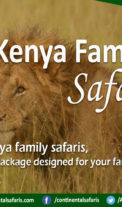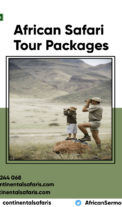Kenyan Camping Budget Safari Adventure
14 Days Tsavo East | Tsavo West | Amboseli | Naivasha | Masai Mara | L. Nakuru | Mt Kenya | Samburu Camping Trip.
Departs daily
Day 1: Arrival - Nairobi
On arrival in Nairobi, met and assisted. Transfer to your budget hotel, Comfort Inn for an overnight on bed and breakfast.
Day 2: Nairobi - Tsavo East
Drive to Tsavo East National Park. Lunch en-route and arrival Tsavo National park - Kenya's largest game sanctuary famed for its huge herds of elephants. It is also home to lion, rhino, giraffe and zebra as well as a variety of other smaller game. Arrival and you will have a game drive en-route. Dinner and overnight at your campsite, B,L,D.
Day 3: Tsavo West
Game drives in Tsavo. There is also the shetani lava flow, crying stones and a remarkable number of bird’s life. As the sun sets, this mighty mountain may become visible from it’s cover of clouds and provides a panoramic view as a perfect end to a long day of game viewing. Dinner and overnight at your campsite, B,L,D.
Day 4: Amboseli
Depart after breakfast to Amboseli National Park a place of stark contrast. The greatest attraction is the vast herds of Elephants. Amboseli National Park is dominated by Mount Kilimanjaro the highest Mountain in Africa. Dinner will be served at the mobile camp, B,L,D.
Day 5: Amboseli
The early morning and late evening game drives is a must both for the quality of viewing and for the atmosphere of the wilds of Africa. Mount Kilimanjaro will provide a beautiful back drop. Meals will be provided at the mobile camp. Overnight at the campsite, B,L,D.
Day 6: Lake Naivasha
Depart to Lake Naivasha. Lunch enroute. Arrival at the campsite and check in. Afternoon is free for a boat ride or a tour to the Crescent Island should not be missed, It is one of the few places in all of Africa where you can wander on foot among herds of Zebra, Wildebeest, gazelles and giraffes. The Lake is a birds’ paradise and has a larger number of hippos. Dinner and overnight at your mobile tents, B,L,D.
Day 7: Masai Mara
After breakfast you will depart from Naivasha to Masai Mara Game Reserve, you will cross the valley floor to Narok and by late afternoon you will have arrived at our semi-permanent campsite and have time for a game drive before being served dinner and taking a welcome overnight rest, B,L,D.
Day 8 & 9: Masai Mara
Depart after breakfast for a full day game drive which will give you sufficient time to view the wide variety of wildlife available at this vast reserve. Game to be seen includes Zebra, Giraffe, Antelopes, Hyena and virtually every type of wildlife available in Kenya. Over 95 species of mammals are found in this great reserve. Besides mammals, over 350 bird species have been recorded here. Dinner and overnight at the Campsite, B,L,D.
Optional activities:
-Visit to a local Maasai village for a Maasai cultural tour: US$ 25 per person
-Hot air balloon ride: US$ 395 per person
Day 10: Masai Mara - Lake Nakuru
After breakfast depart to Lake Nakuru National Park. This lake is famous for its Flamingos but there are other types of birds living and feeding there. Apart from birds Lake Nakuru offers a wide variety of small game such as Waterbuck, Impala, Gazelle and Buffalo. It is a sanctuary for both the white and black rhino. Overnight at Nakuru, B,L,D.
Day 11: Mount Kenya
After breakfast depart to the base of Mount Kenya at Mountain Rock Camp with lunch. Afternoon enjoy a guided walk on the lower slopes of Mt Kenya to the 'Mau Mau' caves - used by freedom fighters as hiding grounds. Return for dinner and overnight at the camp, B,L,D.
Day 12: Samburu
After breakfast, drive to Samburu Game Reserve. You will cross the equator where you will have an 'Equator ceremony' as you continue to Kenya's semi-arid area, the Samburu National Reserve. Lunch enroute. Arrival Samburu and game drive en route to the campsite. Dinner and overnight at the campsite, B,L,D.
Day 13: Samburu
Early game drives at the park. Samburu Reserve has some unique five to include, Reticulated Giraffe, Grevy Zebra, Beisa Oryx, Somali Ostrich, and the long neck Gerenuk Antelope. Other animals to be found include, Lion, Leopard, Elephant, and Cheetah amongst others. All meals at the campsite, B,L,D.
Day 14: Nairobi
Early morning game drive before breakfast. Return for breakfast at the campsite. After breakfast you depart to Nairobi to arrive by approximately 2pm, B,L,.
Tour Price: US$ 2,170 per person sharing.
Tour cost includes:
.Guarantee price/guarantee safari on confirmation
.Full board accommodation on safari
.Accommodation in two person tents.
.Meal plan as described, B=Breakfast, L=Lunch and D=Dinner
.Transportation in a safari minibus, driven by English-speaking driver/guide
.Park entrance fees including local government taxes
.Bottled water whilst on game drives
.All game drives as detailed in the itinerary
.Start and finish in Nairobi
.Sleeping tents and mats
.1 night accommodation in Nairobi on bed and breakfast at Comfort Inn
.Airport transfer in Nairobi
Net tour price excludes:
.Laundry & sleeping bags
.Tips & drinks
.International flights
.Visas to Kenya
.Items of personal nature
.Any other extras not detailed in the above itinerary
African Adventure Camping, Kenya Budget Camping Safaris, 14 Days Kenya camping safaris, budget Kenya Masai Mara camping, Amboseli tour, budget safaris, Samburu, Mombasa, Mara camping, budget safaris, Maasai Mara safaris, Kenya wildlife camping tours , camping in Kenya, Tsavo
THE MASAI MARA MIGRATION OF WILDEBEESTS:
The Wildebeest arrive at the Mara River around July and cross over onto the Masai Mara plains. The wildebeest remain here until October, when they return to Tanzania. Gazetted in 1961, the Reserve is located west of the Rift Valley and is a natural extension of the Serengeti plains. The Mara River, the reserve's backbone, traverses north to south. This river course is the natural barrier crossed every year by the large herds of wildebeest and zebra during their migration.
May & June
In late May, the herds leave the Western Corridor for the northern Serengeti plains and woodlands. The fresh, tender and mineral-rich pastures on the other side of the humans' border, in Masai Mara, are the irresistible bait for the animals to finally invade the Kenyan reserve, an event which usually starts in late June to early July. The troops coming from the south meet here another migratory contingent: the resident wildebeest herds of the Mara region. These animals reside in the Loita Plains and Hills, northeast of the Mara, until the dry season brings the tougher days and it is time to seek the evergreen Mara basin.
July to October
Throughout the month of July, the herds cross the Sand River, a mostly dry tributary of the Mara which roughly follows the boundary line between Kenya and Tanzania. The parade takes the eastern sector of Masai Mara, surrounding the Keekorok Lodge area. The trek follows westward, leading the herds to face the major challenge along their quest: crossing the Mara river and frequently also its tributary, the Talek. By then, the rains at the Mau Escarpment, where the Mara rises, have fed the stream to its highest levels.
The steep banks are populated with trunk-looking basking crocodiles that seem almost to be expecting their annual banquet. The operation of fording the river is the most delicate along the migration, and as such seems to plunge the gnus in a state of anxiety that only relieves when the whole herd has crossed. The trekkers walk along the left (eastern) bank of the Mara looking for a suitable point to cross. There are plenty of preferred crossings along the course, which are easily identifiable by the lack of vegetation, the depressed slopes and the deep grooves carved by the animals' hooves. These are the most secure places to ford the river, those that ensure a minimal mortality. Nonetheless, the apparent programming of the whole process sometimes seems to collapse, and the nervous herds occasionally choose places where the banks are too steep and many of the animals break their legs down the cliff or fall flat into the waters. The herds gather at the suitable points and wander around nervously, their grunts sounding loud in the air. Eventually, one animal takes the lead and approaches the rim, scanning the opposite edge to analyze if any danger awaits after the crossing. When it finally dives into the stream, this seems to haul the rest of the herd. More animals follow in a single line across the river, while the lagged ones throw themselves towards the stream until the rearguard pushes the troops to a frantic race that ends up with some animals trampled to death, lying aside the course. Along the boreal summer, the crossings repeat over and over, and the survivors graze peacefully on the Mara Triangle grasslands unless disturbed by the early-morning and late-evening hunts of lion and cheetah, the latter preying on the calves.
By October, the rains are heading south back to the Serengeti. This is when the pace of the march reverses, bringing the herds to face once more the quest for the southern grasslands. The rite of fording the river is again part of nature's call. In the last days of October, the migration heads towards the vast plains of the southern Serengeti, where a new generation of calves will be born to start the cycle of life all over again. Normally the route is down the eastern side and the pace is fast. Quite often a million animals can be seen stretched out.
BALLOONING OVER THE MASAI MARA:
Visitors to the Masai Mara can experience the rare excitement of game viewing from a hot air balloon. In the crisp air of dawn, the passengers drink coffee while the crew partially inflates the balloon with enormous fans. The gas burners are then ignited and the balloon fills with hot air slowly raising the baskets. Before departing, finalized checks are made, and the passengers then climb into the balloon basket for a take off.
The balloons lift off just before sunrise when the breeze on the plains is still cold. Once airborne, the balloons are blown by the prevailing winds across the broad landscape. Apart from the hiss of the burners, the flight above the Masai Mara plains is magically silent. The pilot controls the height of the craft by regulating the flow of hot air into the balloon. Sometimes the balloon will descend over the plains for a close up view of the wildlife; on other occasions, it rises to clear a tree canopy and rise over the reverine forest.
At the end of the flight, the passengers are treated to a champagne breakfast, complete with flowers. China and crystal are set out on the table that is placed under a convenient acacia tree. The finishing touch to the flight is a game drive back to the lodge or camp, and the possibility of seeing the same pride of lions, or herd of elephants that had been viewed while ballooning. Over a dozen balloons depart from sites near six of the lodges and tented camps. Our customers are often able to view four of the 'Big Five' while ballooning. A flight certificate is issued on completion of the balloon safari.
Wildebeest migration Safaris, Maasai Mara migration safari, Wildebeest migration, wildlife migration Serengeti Maasai Mara Migration, Masai Mara Migration Safaris, Maasai Wildebeest Migration, Maasai Mara Migration Safaris, Masai Wildebeest Migration, Maasai people and cultural tour, Kenya Masai Mara balloon ride, Masai Mara balloon ride, Masai Mara Balloon Safaris, , Masai Mara Kenya, Kenya balloon ride.








Recent Comments